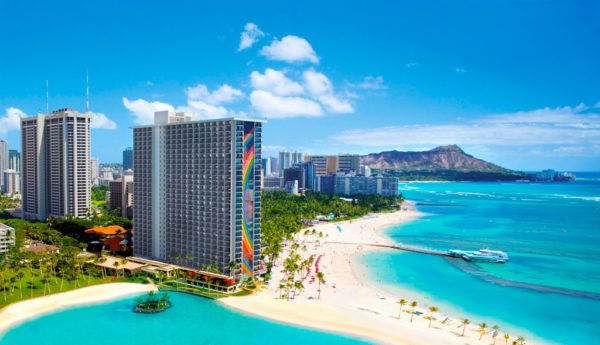When mainlanders think of the islands of Hawai’i, the dream tends to be of palm trees, white sandy beaches, and a culture of fun and sun. For many, it’s a vacation of a lifetime, enjoyed at grand hotels with golf courses stretching to the ocean.
For many native Hawai’ians, however, the islands represent something much different – a land that was stolen from them which has now been turned into a tourist and agribusiness resource colony. Wholly self-sufficient as recently as fifty years ago, the islands are now almost completely dependent on food imports – shipments that must travel over 2,500 miles to reach the islands.
Hawai’i’s transformation, unfortunately, is not unique. As with the Caribbean islands in the 17th and 18th centuries, colonization of the Hawai’ian islands took place in stages.
First, the islands were forcibly taken by the United States in the country’s ever-expanding westward march across the Pacific Ocean. Then, ownership of land on the islands was parceled out to the largest and most influential corporations. Finally, the islands were harnessed into the highest and best use for the U.S. government – for tourist dollars flowing to those large economic actors, and for sugar and other commodities to flow into corporate coffers.
Colonizing the Law
Colonization, of course, takes many forms. Economic colonization is eased by paying lip service to native Hawai’ian customs, and by assuring Hawai’ians of the importance of the islands to the mainland. Direct U.S. military spending also does a neat trick – investing billions of dollars into the already-rigged economy while using them as a pivotal early-warning outpost in the Pacific.
A big part of colonization is about colonizing the law – taking native traditions and rules and replacing them with a U.S. system of law.
That system is characterized by the U.S. Constitution, which established a heavily centralized federal and state system of government with the blanket authority to override laws adopted by communities. As a not-particularly democratic document, even a U.S. Supreme Court justice has castigated the Constitution, commenting, “(I)f I were drafting a constitution. . .I would not look to the U.S. Constitution.”
By subjecting native Hawai’ians to a system of U.S. constitutional law, any state law that Hawai’ians decide to adopt can be nullified by the federal government; and any local law that Hawai’ians decide to adopt can be nullified by the state government. By superimposing the U.S. constitution on the people of the islands, community decision making was effectively swept away and put into the hands of those who benefit the most from keeping the islands of Hawai’i under the firm hand of another country.

https://unsettlingamerica.wordpress.com/2011/09/29/kuleana-lahui-collective-responsibility-for-hawaiian-nationhood-in-activists%E2%80%99-praxis/
None of which would be a concern if the native Hawai’ian vision for the islands was identical to the vision of the tourist and agribusiness corporations that actually control the islands. But, of course, it’s not.
Because Hawai’ians are unable to use their structure of government to make law to stop harm, their different vision for their home erupts from time to time in the form of blockades and other protests. Whether attempting to block the mega-island Superferry in 2007, or the on-going protests (since 1960) against efforts to build more optical telescopes on the island of Hawai’i’s Mauna Kea volcano, Hawai’ians have mostly been relegated to direct action as a means of last resort to protect their sacred places and the sanctity of their islands.
Hawai’ians have mostly been relegated to direct action as a means of last resort to protect their sacred places and the sanctity of their islands.
Recently, Hawai’ians have also been acting to reclaim their lawmaking authority through their opposition to genetically engineered (GE) crops. On the islands of Kaua’i, Hawai’i, and Maui, a coalition of native Hawai’ians and environmental organizations have advanced island-wide initiatives to regulate and control the spread of GE crops across those islands. While none of those initiatives permanently ban all GE crop and seed use, they seek to slow down the spread of GE crops by requiring studies on their safety, creating buffer zones, and imposing temporary moratoria.
What We Want vs. What We Can Get: Colonizing Ourselves
Colonization can take place in many ways. One of the ways that it occurs is diverting our energy away from organizing for what we actually want, to instead organizing for what we think we can get under the current system.
Large environmental groups in the U.S. have diluted community activism for decades. When coalfield communities wanted to ban strip mining in the 1970s, the large environmental groups steered them toward “practical” alternatives, such as the regulation of the practice, rather than the banning of it. Today, of course, those laws do nothing to keep mountain tops from being blown off in West Virginia, or to prevent longwall coal mining in Appalachia from dewatering streams and polluting drinking water. Long-term effects of those practices, of course, include the combustion of coal, which is not-so-slowly cooking the planet.
And it’s not just stories of yesteryear – today, communities who know that they need to ban fracking, factory farming, pipelines, and other developments are reminded by the large environmental organizations that banning those operations is not only impractical, but illegal and unconstitutional under the U.S. system of law.
Instead of working to build a movement that would change how that system functions, Big Green groups instead work with communities and groups to dilute their efforts, driving forward regulatory buffer zones for fracking, nutrient management plans for factory farms, and requirements for blow-out mechanisms for oil pipelines.

https://www.atlasnetwork.org/news/article/time-lapse-video-captures-growth-of-u.s.-federal-government-regulations
The problem, of course, is that in doing so, those efforts validate the existing system. Under today’s legal system, corporations have more rights than communities, and they’re able to use the state and federal government to stop communities from vetoing corporate projects.
Those large, mainland environmental groups routinely colonize Hawai’i and Hawai’ians, not with sugar plantations or resort hotels, but with a form of activism that more closely resembles appeasement than anything else. Those groups have learned to function within the U.S. system of law to get the best deal possible within it, while not seeking to change the very structure of the system that controls who actually makes key decisions.
Polls across the country routinely show that close to seventy percent of Americans believe that genetic engineering of foods should be banned. Assuming that the same percentage (or higher) of Hawai’ians believe the same thing, why shouldn’t the people of each island be able to ban those foods? Why settle for laws that call for safety studies, buffer zones, and disclosure, when people really want genetic food engineering banned?
The answer lies within us – requiring us to recognize that the existing system is defined by our colonizers, not by people and communities – and that we will never be able to break away from that system and build something new so long as we continue to operate within it.
Attempting to operate within the current system eventually runs out of steam as well. Recently, GE laws passed on both the island of Hawai’i and Kaui’i were struck down by a federal judge, who explained that the local laws had been preempted by state law – a state law written to protect the very agribusiness corporations which filed the lawsuits.
We cannot and should not expect the colonizer to free the colonized. And it’s time we recognize that the large groups that have become experts in “working” the current system are not going to save us either. This is something we must do ourselves, beginning in our own communities.
Community Rights Paper #10: Paradise Lost
Visit here for more Community Rights Papers!



